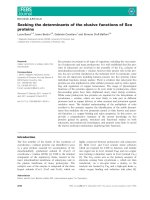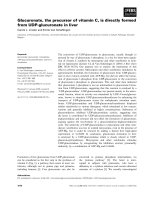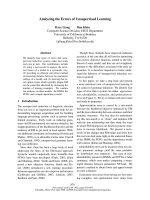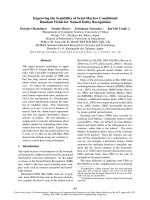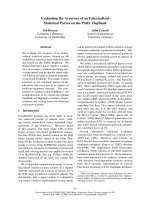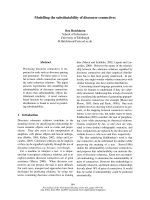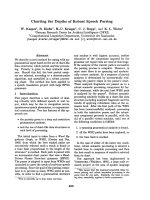Báo cáo khoa học: "Determining the placement of German verbs in English–to–German SMT" ppt
Bạn đang xem bản rút gọn của tài liệu. Xem và tải ngay bản đầy đủ của tài liệu tại đây (149.65 KB, 10 trang )
Proceedings of the 13th Conference of the European Chapter of the Association for Computational Linguistics, pages 726–735,
Avignon, France, April 23 - 27 2012.
c
2012 Association for Computational Linguistics
Determining the placement of German verbs in English–to–German
SMT
Anita Gojun Alexander Fraser
Institute for Natural Language Processing
University of Stuttgart, Germany
{gojunaa, fraser}@ims.uni-stuttgart.de
Abstract
When translating English to German, exist-
ing reordering models often cannot model
the long-range reorderings needed to gen-
erate German translations with verbs in the
correct position. We reorder English as a
preprocessing step for English-to-German
SMT. We use a sequence of hand-crafted
reordering rules applied to English parse
trees. The reordering rules place English
verbal elements in the positions within the
clause they will have in the German transla-
tion. This is a difficult problem, as German
verbal elements can appear in different po-
sitions within a clause (in contrast with En-
glish verbal elements, whose positions do
not vary as much). We obtain a significant
improvement in translation performance.
1 Introduction
Phrase-based SMT (PSMT) systems translate
word sequences (phrases) from a source language
into a target language, performing reordering of
target phrases in order to generate a fluent target
language output. The reordering models, such as,
for example, the models implemented in Moses
(Koehn et al., 2007), are often limited to a cer-
tain reordering range since reordering beyond this
distance cannot be performed accurately. This re-
sults in problems of fluency for language pairs
with large differences in constituent order, such
as English and German. When translating from
English to German, verbs in the German output
are often incorrectly left near their position in En-
glish, creating problems of fluency. Verbs are also
often omitted since the distortion model cannot
move verbs to positions which are licensed by the
German language model, making the translations
difficult to understand.
A common approach for handling the long-
range reordering problem within PSMT is per-
forming syntax-based or part-of-speech-based
(POS-based) reordering of the input as a prepro-
cessing step before translation (e.g., Collins et al.
(2005), Gupta et al. (2007), Habash (2007), Xu
et al. (2009), Niehues and Kolss (2009), Katz-
Brown et al. (2011), Genzel (2010)).
We reorder English to improve the translation
to German. The verb reordering process is im-
plemented using deterministic reordering rules on
English parse trees. The sequence of reorderings
is derived from the clause type and the composi-
tion of a given verbal complex (a (possibly dis-
contiguous) sequence of verbal elements in a sin-
gle clause). Only one rule can be applied in a
given context and for each word to be reordered,
there is a unique reordered position. We train a
standard PSMT system on the reordered English
training and tuning data and use it to translate the
reordered English test set into German.
This paper is structured as follows: in section
2, we outline related work. In section 3, English
and German verb positioning is described. The
reordering rules are given in section 4. In sec-
tion 5, we show the relevance of the reordering,
present the experiments and present an extensive
error analysis. We discuss some problems ob-
served in section 7 and conclude in section 8.
2 Related work
There have been a number of attempts to handle
the long-range reordering problem within PSMT.
Many of them are based on the reordering of a
source language sentence as a preprocessing step
726
before translation. Our approach is related to the
work of Collins et al. (2005). They reordered
German sentences as a preprocessing step for
German-to-English SMT. Hand-crafted reorder-
ing rules are applied on German parse trees in
order to move the German verbs into the posi-
tions corresponding to the positions of the English
verbs. Subsequently, the reordered German sen-
tences are translated into English leading to better
translation performance when compared with the
translation of the original German sentences.
We apply this method on the opposite trans-
lation direction, thus having English as a source
language and German as a target language. How-
ever, we cannot simply invert the reordering rules
which are applied on German as a source lan-
guage in order to reorder the English input. While
the reordering of German implies movement of
the German verbs into a single position, when re-
ordering English, we need to split the English ver-
bal complexes and, where required, move their
parts into different positions. Therefore, we need
to identify exactly which parts of a verbal com-
plex must be moved and their possible positions
in a German sentence.
Reordering rules can also be extracted automat-
ically. For example, Niehues and Kolss (2009)
automatically extracted discontiguous reordering
rules (allowing gaps between POS tags which
can include an arbitrary number of words) from
a word-aligned parallel corpus with POS tagged
source side. Since many different rules can be ap-
plied on a given sentence, a number of reordered
sentence alternatives are created which are en-
coded as a word lattice (Dyer et al., 2008). They
dealt with the translation directions German-to-
English and English-to-German, but translation
improvement was obtained only for the German-
to-English direction. This may be due to miss-
ing information about clause boundaries since En-
glish verbs often have to be moved to the clause
end. Our reordering has access to this kind of
knowledge since we are working with a full syn-
tactic parser of English.
Genzel (2010) proposed a language-
independent method for learning reordering
rules where the rules are extracted from parsed
source language sentences. For each node, all
possible reorderings (permutations) of a limited
number of the child nodes are considered. The
candidate reordering rules are applied on the
dev set which is then translated and evaluated.
Only those rule sequences are extracted which
maximize the translation performance of the
reordered dev set.
For the extraction of reordering rules, Gen-
zel (2010) uses shallow constituent parse trees
which are obtained from dependency parse trees.
The trees are annotated using both Penn Tree-
bank POS tags and using Stanford dependency
types. However, the constraints on possible re-
orderings are too restrictive in order to model all
word movements required for English-to-German
translation. In particular, the reordering rules in-
volve only the permutation of direct child nodes
and do not allow changing of child-parent rela-
tionships (deleting of a child or attaching a node
to a new father node). In our implementation, a
verb can be moved to any position in a parse tree
(according to the reordering rules): the reordering
can be a simple permutation of child nodes, or at-
tachment of these nodes to a new father node (cf.
movement of bought and read in figure 1
1
).
Thus, in contrast to Genzel (2010), our ap-
proach does not have any constraints with respect
to the position of nodes marking a verb within the
tree. Only the syntactic structure of the sentence
restricts the distance of the linguistically moti-
vated verb movements.
3 Verb positions in English and German
3.1 Syntax of German sentences
Since in this work, we concentrate on verbs, we
use the notion verbal complex for a sequence con-
sisting of verbs, verbal particles and negation.
The verb positions in the German sentences de-
pend on clause type and the tense as shown in ta-
ble 1. Verbs can be placed in 1st, 2nd or clause-
final position. Additionally, if a composed tense
is given, the parts of a verbal complex can be
interrupted by the middle field (MF) which con-
tains arbitrary sentence constituents, e.g., sub-
jects and objects (noun phrases), adjuncts (prepo-
sitional phrases), adverbs, etc. We assume that the
German sentences are SVO (analogously to En-
glish); topicalization is beyond the scope of our
work.
In this work, we consider two possible posi-
tions of the negation in German: (1) directly in
1
The verb movements shown in figure 1 will be explained
in detail in section 4.
727
1st 2nd MF clause-
final
decl
subject finV any ∅
subject finV any mainV
int/perif
finV subject any ∅
finV subject any mainV
sub/inf
relCon subject any finV
relCon subject any VC
Table 1: Position of the German subjects and verbs
in declarative clauses (decl), interrogative clauses and
clauses with a peripheral clause (int/perif ), subordi-
nate/infinitival (sub/inf ) clauses. mainV = main verb,
finV = finite verb, VC = verbal complex, any = arbi-
trary words, relCon = relative pronoun or conjunction.
We consider extraponed consituents in perif, as well as
optional interrogatives in int to be in position 0.
front of the main verb, and (2) directly after the
finite verb. The two negation positions are illus-
trated in the following examples:
(1) Ich
I
behaupte,
claim
dass
that
ich
I
es
it
nicht
not
gesagt
say
habe.
did.
(2) Ich
I
denke
think
nicht,
not
dass
that
er
he
das
that
gesagt
said
hat.
has.
It should, however, be noted that in German, the
negative particle nicht can have several positions
in a sentence depending on the context (verb argu-
ments, emphasis). Thus, more analysis is ideally
needed (e.g., discourse, etc.).
3.2 Comparison of verb positions
English and German verbal complexes differ both
in their construction and their position. The Ger-
man verbal complex can be discontiguous, i.e., its
parts can be placed in different positions which
implies that a (large) number of other words can
be placed between the verbs (situated in the MF).
In English, the verbal complex can only be inter-
rupted by adverbials and subjects (in interrogative
clauses). Furthermore, in German, the finite verb
can sometimes be the last element of the verbal
complex, while in English, the finite verb is al-
ways the first verb in the verbal complex.
In terms of positions, the verbs in English and
German can differ significantly. As previously
noted, the German verbal complex can be discon-
tiguous, simultaneously occupying 1st/2nd and
clause-final position (cf. rows decl and int/perif in
table 1), which is not the case in English. While in
English, the verbal complex is placed in the 2nd
position in declarative, or in the 1st position in in-
terrogative clauses, in German, the entire verbal
complex can additionally be placed at the clause
end in subordinate or infinitival clauses (cf. row
sub/inf in table 1).
Because of these differences, for nearly all
types of English clauses, reordering is needed in
order to place the English verbs in the positions
which correspond to the correct verb positions in
German. Only English declarative clauses with
simple present and simple past tense have the
same verb position as their German counterparts.
We give statistics on clause types and their rele-
vance for the verb reordering in section 5.1.
4 Reordering of the English input
The reordering is carried out on English parse
trees. We first enrich the parse trees with clause
type labels, as described below. Then, for each
node marking a clause (S nodes), the correspond-
ing sequence of reordering rules is carried out.
The appropriate reordering is derived from the
clause type label and the composition of the given
verbal complex. The reordering rules are deter-
ministic. Only one rule can be applied in a given
context and for each verb to be reordered, there is
a unique reordered position.
The reordering procedure is the same for the
training and the testing data. It is carried out
on English parse trees resulting in modified parse
trees which are read out in order to generate the
reordered English sentences. These are input for
training a PSMT system or input to the decoder.
The processing steps are shown in figure 1.
For the development of the reordering rules, we
used a small sample of the training data. In par-
ticular, by observing the English parse trees ex-
tracted randomly from the training data, we de-
veloped a set of rules which transform the origi-
nal trees in such a way that the English verbs are
moved to the positions which correspond to the
placement of verbs in German.
4.1 Labeling clauses with their type
As shown in section 3.1, the verb positions in Ger-
man depend on the clause type. Since we use En-
glish parse trees produced by the generative parser
of Charniak and Johnson (2005) which do not
have any function labels, we implemented a sim-
ple rule-based clause type labeling script which
728
.
.
.
.
WHNP
which
NP
DT NN
a book
Yesterday
RB
ADVP
,
,
S−EXTR
I
PRP
NP
NP
JJ NN
last week
NP
PRP
I
Yesterday
RB
ADVP
,
,
I
PRP
NP
S−EXTR
NP
JJ NN
last week
NP
PRP
I
NP
DT NN
a book
NP
S−SUB
S
VP
VBD
read
VBD
bought
NP
WHNP
which
S−SUB
S
VP
VBD
bought
VBD
read
reordering
read out and translate
VP
VP
1
1
Figure 1: Processing steps: Clause type labeling an-
notates the given original tree with clause type labels
(in figure, S-EXTR and S-SUB). Subsequently, the re-
ordering is performed (cf. movement of the verbs read
and bought). The reordered sentence is finally read out
and given to the decoder.
enriches every clause starting node with the corre-
sponding clause type label. The label depends on
the context (father, child nodes) of a given clause
node. If, for example, the first child node of a
given S node is WH* (wh-word) or IN (subordi-
nating conjunction), then the clause type label is
SUB (subordinate clause, cf. figure 1).
We defined five clause type labels which indi-
cate main clauses (MAIN), main clauses with a
peripheral clause in the prefield (EXTR), subor-
dinate (SUB), infinitival (XCOMP) and interroga-
tive clauses (INT).
4.2 Clause boundary identification
The German verbs are often placed at the clause
end (cf. rows decl, int/perif and sub/inf in ta-
ble 1), making it necessary to move their En-
glish counterparts into the corresponding posi-
tions within an English tree. For this reason, we
identify the clause ends (the right boundaries).
The search for the clause end is implemented as
a breadth-first search for the next S node or sen-
tence end. The starting node is the node which
marks the verbal phrase in which the verbs are
enclosed. When the next node marking a clause
is identified, the search stops and returns the posi-
tion in front of the identified clause marking node.
When, for example, searching for the clause
boundary of S-EXTR in figure 1, we search re-
cursively for the first clause marking node within
VP
1
, which is S-SUB. The position in front of S-
SUB is marked as clause-final position of S-EXTR.
4.3 Basic verb reordering rules
The reordering procedure takes into account the
following word categories: verbs, verb particles,
the infinitival particle to and the negative parti-
cle not, as well as its abbreviated form ’t. The
reordering rules are based on POS labels in the
parse tree.
The reordering procedure is a sequence of ap-
plications of the reordering rules. For each el-
ement of an English verbal complex, its proper-
ties are derived (tense, main verb/auxiliary, finite-
ness). The reordering is then carried out corre-
sponding to the clause type and verbal properties
of a verb to be processed.
In the following, the reordering rules are pre-
sented. Examples of reordered sentences are
given in table 2, and are discussed further here.
Main clause (S-MAIN)
(i) simple tense: no reordering required
(cf. appears
finV
in input 1);
(ii) composed tense: the main verb is moved to
the clause end. If a negative particle exists, it
is moved in front of the reordered main verb,
while the optional verb particle is moved af-
ter the reordered main verb (cf. [has]
finV
[been developing]
mainV
in input 2).
Main clause with peripheral clause (S-EXTR)
(i) simple tense: the finite verb is moved to-
gether with an optional particle to the 1st po-
sition (i.e. in front of the subject);
(ii) composed tense: the main verb, as well
as optional negative and verb particles are
moved to the clause end. The finite verb is
moved in the 1st position, i.e. in front of the
subject (cf. have
finV
[gone up]
mainV
in in-
put 3).
729
Subordinate clause (S-SUB)
(i) simple tense: the finite verb is moved to the
clause end (cf. boasts
finV
in input 3);
(ii) composed tense: the main verb, as well
as optional negative and verb particles are
moved to the clause end, the finite verb is
placed after the reordered main verb (cf.
have
finV
[been executed]
mainV
in input 5).
Infinitival clause (S-XCOMP)
The entire English verbal complex is moved from
the 2nd position to the clause-final position (cf.
[to discuss]
VC
in input 4).
Interrogative clause (S-INT)
(i) simple tense: no reordering required;
(ii) composed tense: the main verb, as well
as optional negative and verb particles are
moved to the clause end (cf. [did]
finV
know
mainV
in input 5).
4.4 Reordering rules for other phenomena
4.4.1 Multiple auxiliaries in English
Some English tenses require a sequence of aux-
iliaries, not all of which have a German coun-
terpart. In the reordering process, non-finite
auxiliaries are considered to be a part of the
main verb complex and are moved together with
the main verb (cf. movement of has
finV
[been
developing]
mainV
in input 2).
4.4.2 Simple vs. composed tenses
In English, there are some tenses composed of
an auxiliary and a main verb which correspond
to a German tense composed of only one verb,
e.g., am reading ⇔ lese and does John read? ⇔
liest John? Splitting such English verbal com-
plexes and only moving the main verbs would
lead to constructions which do not exist in Ger-
man. Therefore, in the reordering process, the
English verbal complex in present continuous, as
well as interrogative phrases composed of do and
a main verb, are not split. They are handled as
one main verb complex and reordered as a sin-
gle unit using the rules for main verbs (e.g. [be-
cause I am reading a book]
SUB
⇒ because I a
book am reading ⇔ weil ich ein Buch lese.
2
2
We only consider present continuous and verbs in com-
bination with do for this kind of reordering. There are also
4.4.3 Flexible position of German verbs
We stated that the English verbs are never moved
outside the subclause they were originally in. In
German there are, however, some constructions
(infinitival and relative clauses), in which the
main verb can be placed after a subsequent clause.
Consider two German translations of the English
sentence He has promised to come:
(3a) Er
he
hat
has
[zu
to
kommen]
S
come
versprochen.
promised.
(3b) Er
he
hat
has
versprochen,
promised,
[zu
to
kommen]
S
.
come.
In (3a), the German main verb versprochen is
placed after the infinitival clause zu kommen (to
come), while in (3b), the same verb is placed in
front of it. Both alternatives are grammatically
correct.
If a German verb should come after an em-
bedded clause as in example (3a) or precede it
(cf. example (3b)), depends not only on syntac-
tic but also on stylistic factors. Regarding the
verb reordering problem, we would therefore have
to examine the given sentence in order to derive
the correct (or more probable) new verb position
which is beyond the scope of this work. There-
fore, we allow only for reorderings which do not
cross clause boundaries as shown in example (3b).
5 Experiments
In order to evaluate the translation of the re-
ordered English sentences, we built two SMT sys-
tems with Moses (Koehn et al., 2007). As train-
ing data, we used the Europarl corpus which con-
sists of 1,204,062 English/German sentence pairs.
The baseline system was trained on the original
English training data while the contrastive system
was trained on the reordered English training data.
In both systems, the same original German sen-
tences were used. We used WMT 2009 dev and
test sets to tune and test the systems. The baseline
system was tuned and tested on the original data
while for the contrastive system, we used the re-
ordered English side of the dev and test sets. The
German 5-gram language model used in both sys-
tems was trained on the WMT 2009 German lan-
guage modeling data, a large German newspaper
corpus consisting of 10,193,376 sentences.
other tenses which could (or should) be treated in the same
way (cf. has been developing on input 2, table 2). We do not
do this to keep the reordering rules simple and general.
730
Input 1 The programme appears to be successful for published data shows that MRSA is on the decline in the UK.
Reordered The programme appears successful to be for published data shows that MRSA on the decline in the UK is.
Input 2 The real estate market in Bulgaria has been developing at an unbelievable rate - all of Europe has its eyes
on this heretofore rarely heard-of Balkan nation.
Reordered The real estate market in Bulgaria has at an unbelievable rate been developing - all of Europe has its eyes
on this heretofore rarely heard-of Balkan nation.
Input 3 While Bulgaria boasts the European Union’s lowest real estate prices, they have still gone up by 21 percent
in the past five years.
Reordered While Bulgaria the European Union’s lowest real estate prices boasts, have they still by 21 percent in the
past five years gone up.
Input 4 Professionals and politicians from 192 countries are slated to discuss the Bali Roadmap that focuses on
efforts to cut greenhouse gas emissions after 2012, when the Kyoto Protocol expires.
Reordered Professionals and politicians from 192 countries are slated the Bali Roadmap to discuss that on efforts
focuses greenhouse gas emissions after 2012 to cut, when the Kyoto Protocol expires.
Input 5 Did you know that in that same country, since 1976, 34 mentally-retarded offenders have been executed?
Reordered Did you know that in that same country, since 1976, 34 mentally-retarded offenders been executed have?
Table 2: Examples of reordered English sentences
5.1 Applied rules
In order to see how many English clauses are rel-
evant for reordering, we derived statistics about
clause types and the number of reordering rules
applied on the training data.
In table 3, the number of the English clauses
with all considered clause type/tense combination
are shown. The bold numbers indicate combina-
tions which are relevant to the reordering. Over-
all, 62% of all EN clauses from our training data
(2,706,117 clauses) are relevant for the verb re-
ordering. Note that there is an additional category
rest which indicates incorrect clause type/tense
combinations and might thus not be correctly re-
ordered. These are mostly due to parsing and/or
tagging errors.
The performance of the systems was measured
by BLEU (Papineni et al., 2002). The evaluation
results are shown in table 4. The contrastive sys-
tem outperforms the baseline. Its BLEU score is
13.63 which is a gain of 0.61 BLEU points over
the baseline. This is a statistically significant im-
provement at p<0.05 (computed with Gimpel’s
implementation of the pairwise bootstrap resam-
pling method (Koehn, 2004)).
Manual examination of the translations pro-
duced by both systems confirms the result of
the automatic evaluation. Many translations pro-
duced by the contrastive system now have verbs in
the correct positions. If we compare the generated
translations for input sentence 1 in table 5, we
see that the contrastive system generates a trans-
tense MAIN EXTR SUB INT XCOMP
simple 675,095 170,806 449,631 8,739 -
composed 343,178 116,729 277,733 8,817 314,573
rest 98,464 5,158 90,139 306 146,746
Table 3: Counts of English clause types and used
tenses. Bold numbers indicate clause type/tense com-
binations where reordering is required.
Baseline Reordered
BLEU 13.02 13.63
Table 4: Scores of baseline and contrastive systems
lation in which all verbs are placed correctly. In
the baseline translation, only the translation of the
finite verb was, namely war, is placed correctly,
while the translation of the main verb (diagnosed
→ festgestellt) should be placed at the clause end
as in the translation produced by our system.
5.2 Evaluation
Often, the English verbal complex is translated
only partially by the baseline system. For exam-
ple, the English verbal complexes in sentence 2 in
table 5 will climb and will drop are only partially
translated (will climb → wird (will), will drop →
fallen (fall)). Moreover, the generated verbs are
placed incorrectly. In our translation, all verbs are
translated and placed correctly.
Another problem which was often observed in
the baseline is the omission of the verbs in the
German translations. The baseline translation of
the example sentence 3 in table 5 illustrates such
731
a case. There is no translation of the English in-
finitival verbal complex to have. In the transla-
tion generated by the contrastive system, the ver-
bal complex does get translated (zu haben) and
is also placed correctly. We think this is because
the reordering model is not able to identify the
position for the verb which is licensed by the lan-
guage model, causing a hypothesis with no verb
to be scored higher than the hypotheses with in-
correctly placed verbs.
6 Error analysis
6.1 Erroneous reordering in our system
In some cases, the reordering of the English parse
trees fails. Most erroneous reorderings are due to
a number of different parsing and tagging errors.
Coordinated verbs are also problematic due to
their complexity. Their composition can vary, and
thus it would require a large number of different
reordering rules to fully capture this. In our re-
ordering script, the movement of complex struc-
tures such as verbal phrases consisting of a se-
quence of child nodes is not implemented (only
nodes with one child, namely the verb, verbal par-
ticle or negative particle are moved).
6.2 Splitting of the English verbal complex
Since in many cases, the German verbal complex
is discontiguous, we need to split the English ver-
bal complex and move its parts into different posi-
tions. This ensures the correct placement of Ger-
man verbs. However, this does not ensure that the
German verb forms are correct because of highly
ambiguous English verbs. In some cases, we can
lose contextual information which would be use-
ful for disambiguating ambiguous verbs and gen-
erating the appropriate German verb forms.
6.2.1 Subject–verb agreement
Let us consider the English clause in (4a) and its
reordered version in (4b):
(4a) because they have said it to me yesterday.
(4b) because they it to me yesterday said have.
In (4b), the English verbs said have are separated
from the subject they. The English said have can
be translated in several ways into German. With-
out any information about the subject (the dis-
tance between the verbs and the subject can be
very large), it is relatively likely that an erroneous
German translation is generated.
On the other hand, in the baseline SMT system,
the subject they is likely to be a part of a trans-
lation phrase with the correct German equivalent
(they have said → sie haben gesagt). They is then
used as a disambiguating context which is missing
in the reordered sentence (but the order is wrong).
6.2.2 Verb dependency
A similar problem occurs in a verbal complex:
(5a) They have said it to me yesterday.
(5b) They have it to me yesterday said.
In sentence (5a), the English consecutive verbs
have said are a sequence consisting of a finite
auxiliary have and the past participle said. They
should be translated into the corresponding Ger-
man verbal complex haben gesagt. But, if the
verbs are split, we will probably get translations
which are completely independent. Even if the
German auxiliary is correctly inflected, it is hard
to predict how said is going to be translated. If
the distance between the auxiliary habe and the
hypothesized translation of said is large, the lan-
guage model will not be able to help select the
correct translation. Here, the baseline SMT sys-
tem again has an advantage as the verbs are con-
secutive. It is likely they will be found in the train-
ing data and extracted with the correct German
phrase (but the German order is again incorrect).
6.3 Collocations
Collocations (verb–object pairs) are another case
which can lead to a problem:
(6a) I think that the discussion would take place
later this evening.
(6b) I think that the discussion place later this
evening take would.
The English collocation in (6a) consisting of the
verb take and the object place corresponds to the
German verb stattfinden. Without this specific ob-
ject, the verb take is likely to be translated liter-
ally. In the reordered sentence, the verbal com-
plex take would is indeed separated from the ob-
ject place which would probably lead to the literal
translation of both parts of the mentioned collo-
cation. So, as already described in the preceding
paragraphs, an important source of contextual in-
formation is lost which could ensure the correct
translation of the given phrase.
This problem is not specific to English–to–
German. For instance, the same problem occurs
when translating German into English. If, for ex-
732
Input 1 An MRSA - an antibiotic resistant staphylococcus - infection was recently diagnosed in the trauma-
tology ward of J
´
anos hospital.
Reordered
input
An MRSA - an antibiotic resistant staphylococcus - infection was recently in the traumatology ward
of J
´
anos hospital diagnosed.
Baseline
translation
Ein
A
MRSA
MRSA
-
-
ein
an
Antibiotikum
antibiotic
resistenter
resistant
Staphylococcus
Staphylococcus
-
-
war
was
vor
before
kurzem
recent
in
in
der
the
festgestellt
diagnosed
traumatology
traumatology
Ward
ward
von
of
J
´
anos
J
´
anos
Krankenhaus.
hospital.
Reordered
translation
Ein
A
MRSA
MRSA
-
-
ein
an
Antibiotikum
antibiotic
resistenter
resistant
Staphylococcus
Staphylococcus
-
-
Infektion
infection
wurde
was
vor
before
kurzem
recent
in
in
den
the
traumatology
traumatology
Station
ward
der
of
J
´
anos
J
´
anos
Krankenhaus
hospital
diagnostiziert.
diagnosed.
Input 2 The ECB predicts that 2008 inflation will climb to 2.5 percent from the earlier 2.1, but will drop
back to 1.9 percent in 2009.
Reordered
input
The ECB predicts that 2008 inflation to 2.5 percent from the earlier 2.1 will climb, but back to 1.9
percent in 2009 will drop.
Baseline
translation
Die
The
EZB
ECB
sagt,
says,
dass
that
2008
2008
die
the
Inflationsrate
inflation rate
wird
will
auf
to
2,5
2.5
Prozent
percent
aus
from
der
the
fr
¨
uheren
earlier
2,1,
2.1,
sondern
but
fallen
fall
zur
¨
uck
back
auf
to
1,9
1.9
Prozent
percent
im
in the
Jahr
year
2009.
2009.
Reordered
translation
Die
The
EZB
ECB
prophezeit,
predicts,
dass
that
2008
2008
die
the
Inflation
inflation rate
zu
to
2,5
2.5
Prozent
percent
aus
from
der
the
fr
¨
uheren
earlier
2,1
2.1
ansteigen
climb
wird,
will,
aber
but
auf
to
1,9
1.9
Prozent
percent
in
in
2009
2009
sinken
fall
wird.
will.
Input 3 Labour Minister M
´
onika Lamperth appears not to have a sensitive side.
R. input Labour Minister M
´
onika Lamperth appears a sensitive side not to have .
Baseline
translation
Arbeitsminister
Labour Minister
M
´
onika
M
´
onika
Lamperth
Lamperth
scheint
appears
nicht
not
eine
a
sensible
sensitive
Seite.
side.
Reordered
translation
Arbeitsminister
Labour Minister
M
´
onika
M
´
onika
Lamperth
Lamperth
scheint
appears
eine
a
sensible
sensitive
Seite
side
nicht
not
zu
to
haben.
have.
Table 5: Example translations, the baseline has problems with verbal elements, reordered is correct
ample, the object Kauf (buying) of the colloca-
tion nehmen + in Kauf (accept) is separated from
the verb nehmen (take), they are very likely to be
translated literally (rather than as the idiom mean-
ing “to accept”), thus leading to an erroneous En-
glish translation.
6.4 Error statistics
We manually checked 100 randomly chosen En-
glish sentences to see how often the problems de-
scribed in the previous sections occur. From a
total of 276 clauses, 29 were not reordered cor-
rectly. 20 errors were caused by incorrect parsing
and/or POS tags, while the remaining 9 are mostly
due to different kinds of coordination. Table 6
shows correctly reordered clauses which might
pose a problem for translation (see sections 6.2–
6.3). Although the positions of the verbs in the
translations are now correct, the distance between
subjects and verbs, or between verbs in a single
VP might lead to the generation of erroneously
inflected verbs. The separate generation of Ger-
man verbal morphology is an interesting area of
future work, see (de Gispert and Mari
˜
no, 2008).
We also found 2 problematic collocations but note
that this only gives a rough idea of the problem,
further study is needed.
6.5 POS-based disambiguation of the
English verbs
With respect to the problems described in 6.2.1
and 6.2.2, we carried out an experiment in which
733
total d ≥ 5 tokens
subject–verb 40 19
verb dependency 32 14
collocations 8 2
Table 6: total is the number of clauses found for the
respective phenomenon. d ≥ 5 tokens is the number of
clauses where the distance between relevant tokens is
at least 5, which is problematic.
Baseline + POS Reordered + POS
BLEU 13.11 13.68
Table 7: BLEU scores of the baseline and the con-
trastive SMT system using verbal POS tags
we used POS tags in order to disambiguate the
English verbs. For example, the English verb said
corresponds to the German participle gesagt, as
well as to the finite verb in simple past, e.g. sagte.
We attached the POS tags to the English verbs in
order to simulate a disambiguating suffix of a verb
(e.g. said ⇒ said VBN, said VBD). The idea be-
hind this was to extract the correct verbal trans-
lation phrases and score them with appropriate
translation probabilities (e.g. p(said VBN, gesagt)
> p(said VBN, sagte).
We built and tested two PSMT systems using
the data enriched with verbal POS tags. The
first system is trained and tested on the original
English sentences, while the contrastive one was
trained and tested on the reordered English sen-
tences. Evaluation results are shown in table 7.
The baseline obtains a gain of 0.09 and the con-
trastive system of 0.05 BLEU points over the cor-
responding PSMT system without POS tags. Al-
though there are verbs which are now generated
correctly, the overall translation improvement lies
under our expectation. We will directly model the
inflection of German verbs in future work.
7 Discussion and future work
We implemented reordering rules for English ver-
bal complexes because their placement differs
significantly from German placement. The imple-
mentation required dealing with three important
problems: (i) definition of the clause boundaries,
(ii) identification of the new verb positions and
(iii) correct splitting of the verbal complexes.
We showed some phenomena for which a
stochastic reordering would be more appropriate.
For example, since in German, the auxiliary and
the main verb of a verbal complex can occupy
different positions in a clause, we had to define
the English counterparts of the two components
of the German verbal complex. We defined non-
finite English verbal elements as a part of the main
verb complex which are then moved together with
the main verb. This rigid definition could be re-
laxed by considering multiple different splittings
and movements of the English verbs.
Furthermore, the reordering rules are applied
on a clause not allowing for movements across the
clause boundaries. However, we also showed that
in some cases, the main verbs may be moved after
the succeeding subclause. Stochastic rules could
allow for both placements or carry out the more
probable reordering given a specific context. We
will address these issues in future work.
Unfortunately, some important contextual in-
formation is lost when splitting and moving En-
glish verbs. When English verbs are highly am-
biguous, erroneous German verbs can be gener-
ated. The experiment described in section 6.5
shows that more effort should be made in order to
overcome this problem. The incorporation of sep-
arate morphological generation of inflected Ger-
man verbs would improve translation.
8 Conclusion
We presented a method for reordering English as a
preprocessing step for English–to–German SMT.
To our knowledge, this is one of the first papers
which reports on experiments regarding the re-
ordering problem for English–to–German SMT.
We showed that the reordering rules specified in
this work lead to improved translation quality. We
observed that verbs are placed correctly more of-
ten than in the baseline, and that verbs which were
omitted in the baseline are now often generated.
We carried out a thorough analysis of the rules
applied and discussed problems which are related
to highly ambiguous English verbs. Finally we
presented ideas for future work.
Acknowledgments
This work was funded by Deutsche Forschungs-
gemeinschaft grant Models of Morphosyntax for
Statistical Machine Translation.
734
References
Eugene Charniak and Mark Johnson. 2005. Coarse-
to-fine n-best parsing and MaxEnt discriminative
reranking. In ACL.
Michael Collins, Philipp Koehn, and Ivona Ku
ˇ
cerov
´
a.
2005. Clause restructuring for statistical machine
translation. In ACL.
Adri
`
a de Gispert and Jos
´
e B. Mari
˜
no. 2008. On the
impact of morphology in English to Spanish statis-
tical MT. Speech Communication, 50(11-12).
Chris Dyer, Smaranda Muresan, and Philip Resnik.
2008. Generalizing word lattice translation. In
ACL-HLT.
Dmitriy Genzel. 2010. Automatically learning
source-side reordering rules for large scale machine
translation. In COLING.
Deepa Gupta, Mauro Cettolo, and Marcello Federico.
2007. POS-based reordering models for statistical
machine translation. In Proceedings of the Machine
Translation Summit (MT-Summit).
Nizar Habash. 2007. Syntactic preprocessing for sta-
tistical machine translation. In Proceedings of the
Machine Translation Summit (MT-Summit).
Jason Katz-Brown, Slav Petrov, Ryan McDon-
ald, Franz Och, David Talbot, Hiroshi Ichikawa,
Masakazu Seno, and Hideto Kazawa. 2011. Train-
ing a parser for machine translation reordering. In
EMNLP.
Philipp Koehn, Hieu Hoang, Alexandra Birch,
Chris Callison-Burch, Marcello Federico, Nicola
Bertoldi, Brooke Cowan, Wade Shen, Christine
Moran, Richard Zens, Chris Dyer, Ondrej Bojar,
Alexandra Constantin, and Evan Herbst. 2007.
Moses: Open source toolkit for statistical machine
translation. In ACL, Demonstration Program.
Philipp Koehn. 2004. Statistical significance tests for
machine translation evaluation. In EMNLP.
Jan Niehues and Muntsin Kolss. 2009. A POS-based
model for long-range reorderings in SMT. In EACL
Workshop on Statistical Machine Translation.
Kishore Papineni, Salim Roukos, Todd Ward, and
Wei-Jing Zhu. 2002. BLEU: a method for auto-
matic evaluation of machine translation. In ACL.
Peng Xu, Jaecho Kang, Michael Ringgaard, and Franz
Och. 2009. Using a dependency parser to improve
SMT for subject-object-verb languages. In NAACL.
735
